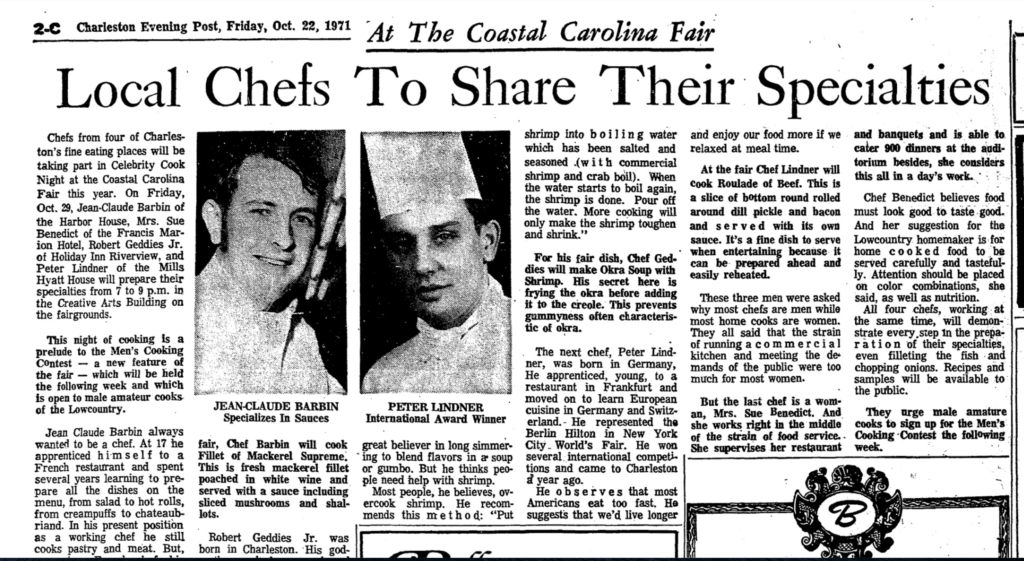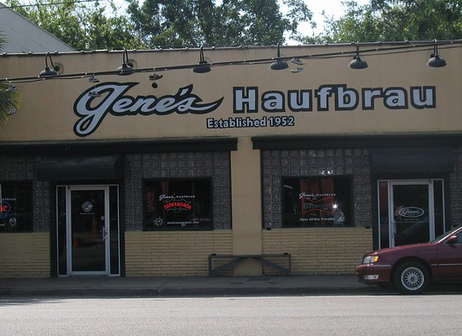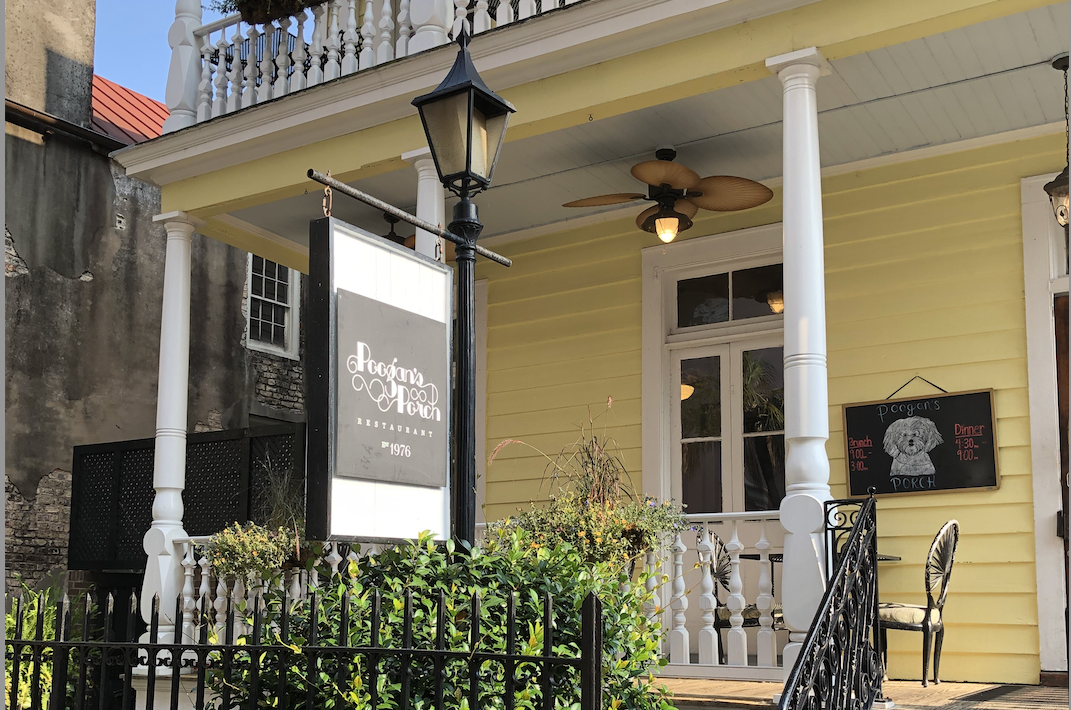One of the perks of living in the Lowcountry is the amazing cuisine and our reputation for hospitality. Charleston’s oldest restaurants, Henry’s, 82 Queen, Poogan’s Porch, and Gene’s Haufbrau, have survived for a reason – they offer delicious renditions of some of the Lowcountry’s most iconic dishes in interesting historic settings that bring locals and tourists back in time to the beginnings of the city’s continuing culinary heyday.
Charleston’s staple foods that locals have long enjoyed in their private homes, but which have only recently entered the wider American lexicon with food shows, culinary study, and the opening of several important early restaurants include shrimp and grits, she crab soup, pimento cheese, and rice with everything. She crab soup, a creamy bisque with sherry and chunks of crab meat, was perfected by William Deas in the early 1900s. He was a renowned African American chef who offered it at Everett’s restaurant on Cannon Street. Indeed, many of the Lowcountry’s signature dishes owe their origins to African American food ways. Rice, for example, was grown throughout coastal South Carolina by the enslaved, who also created dishes featuring rice as a main ingredient, both for themselves and in their capacity as cooks and chefs in private dining rooms and later, in local restaurants.

Shrimp and grits, or simply ‘shrimp and hominy’ in the past, began as a hearty breakfast food using fresh cooked corn grits topped with last night’s shrimp cooked in bacon fat and butter.

Pimento cheese, an acquired but beloved local taste, includes cream cheese, shredded cheese, and spicy, sweet pimento peppers blended into a spread commonly eaten on crackers or in small white bread sandwiches. These were common for afternoon tea and as appetizers.

Some of the first (and now lost) restaurants to cater to visitors opened in the early twentieth century. Robert F. Moss notes that according to the 1912 New Guide to Modern Charleston, ‘all the tourists “take at least one dinner at the Palace Café.” Located at the corner of King and Market streets, the Palace was noted for rice-fed Georgetown duck, which was prepared “a la South Carolina.” The Occidental Restaurant, also on Market Street near Meeting, was known for its steaks, fish dinners, oysters, and shrimp and was a favorite haunt of the countryside’s few remaining planters when they came into the city. Down the block, Riddock’s Arcade catered to “the lady trade,” serving oysters and shad from Edisto, wild duck from Georgetown, and quail from the Sea Islands.” These early restaurants served the big meal of the day in the early afternoon, following the local tradition known as “three o clock dinner”, mentioned by famous Charleston author Josephine Pinckney in a book by that name published in 1945. Perdita’s (which operated on Exchange Street from 1953 to 1980) is still missed by Charlestonians and offered French haut cuisine with Lowcountry seafood flare.

Henry’s on North Market Street is Charleston’s oldest continuously operating restaurant. It began as a grocery in the nineteenth century and reopened its doors in 1932 as a lunchroom, bar, and dinner establishment offering local staples to local folks (the Market was a far cry from the clean, family friendly place it is today, and in the 1930s was home to seedier bars and groceries rather than T-shirt shops and ice cream stores.) Henry’s building was constructed before 1850 and was a barber shop and then Gorse Grocery. Henry Hasselmeyer, a young German immigrant, worked as a clerk and lived above the grocery in 1886, and formed a partnership with Gorse to grow the grocery and liquor retail business at 54 North Market. In 1894, Gorvernor Pitchfork Ben Tillman foisted a state-wide prohibition, and grocers like Henry continued to sell liquor, now illegally. Gorse and Hasselmeyer ended up in court several times, and the grocery was even raided, but the business outlasted both state and federal prohibition and was formerly incorporated in July 1935 as Henrys Inc., “a general restaurant business to deal in foods and beverages”, run by Hasselmeyer, his son Henry Jr., and son in law Walter Shaffer.

Henry’s was transformed from a “beery saloon serving deviled crabs” to a fine dining establishment by chef John Bolton, who began as an entry level cook at the restaurant just after World War Two. In his era, the waiters wore white jackets and black bowties and served relish trays with pimento cheese and fancy seafood dishes. In 1985, the restaurant changed hands and continues the reinvent itself with the times, but Henry’s still offers some of its early staples: she crab soup and fried crab sandwiches, and live music in the bar upstairs, reminiscent of its speakeasy days.

The next oldest Charleston restaurant on the peninsula is Poogan’s Porch, which opened in 1976 on Queen Street and has remained a favorite with locals. The restaurant is located in a historic wood frame house with wide south facing porches and original heart pine floors, built in 1891.

The quaint restaurant is named for a little dog who used to live on site: “By 1976, the character of the neighborhood had changed suitably to allow for the conversion of the house into a restaurant. The last residential owners of the site sold their home and moved away, leaving behind the neighborhood dog that they had grown so accustomed to caring for over the years . . . he had been a neighborhood fixture, graciously accepting table scraps and back scratches from every family on the block. His name was Poogan, and he became the guardian of the fledgling restaurant. From his perch on the front porch, he presided over the renovation process, and when we opened our doors for business, he greeted our first guests warmly. The restaurant family cherished him. He became an institution. Poogan died a natural death in 1979. This building is his monument.”

Poogan’s specializes in upscale but unpretentious southern cuisine and is known for their fabulous buttermilk biscuits and sausage gravy, fried green tomatoes, fried chicken, and seared salmon. They cater to everyone, with a kid’s as well as a full cocktail menu and well stocked bar.

Along with Poogan’s, 82 Queen, which opened in 1982, was one of the first formal restaurants in Charleston to offer Lowcountry cuisine. A Post and Courier article from that year proudly listed composer and head of Spoleto Festival USA, Gian Carlo Minotti’s local picks: “when dining in Charleston, Menotti says his favorite is Henry’s where he particularly likes the stuffed crab. He also have lunch at Sprouts and Krauts and is very fond of the oatmeal and raisin cookies there. He also has dined at the Mills House and at 82 Queen, a new restaurant he says he particularly enjoys.” 82 Queen has stayed true to its original menu.

Their website describes their culinary approach: “Feeling that there was a portion of Charleston’s culinary heritage that was being overlooked, 82 Queen’s original menu featured dishes influenced by the African, French, Caribbean and Anglo-Saxon tastes which permeated the area. 82 Queen’s fusion of these culturally diverse flavors led to the rise of a culinary genre that had been previously undefined – and is now referred to as “Lowcountry Cuisine”. As the years rolled on, 82 Queen adapted and has remained a powerhouse in Charleston’s culinary community.” 82 Queen is known for their barbecue shrimp and grits, crab cakes, and arguably the best she crab soup in the city. Diners can enjoy lunch, weekend brunch, or dinner in the interior rooms of the former house-turned restaurant, or in the spacious, romantic rear courtyards.

Located off the peninsula on Highway 17 in West Ashley, no list of Charleston’s oldest restaurants would be complete without a nod to Gene’s Haufbrau, established in 1952 as a bar and restaurant. Gene’s is situated on a popular strip within Avondale, a kitsch mid twentieth century restaurant and commercial hub. Replete with pool tables and its original midcentury glass block storefront, Gene’s has hardly changed since it opened. They offer an eclectic mix of pub food (loaded fries, corn dogs), southern treats (fried green tomatoes and crawfish salad), and German staples (Gene’s famous wiener schnitzel) with a full draft list living up to their origins as an ale house.

It’s easy to see why Henry’s, Poogan’s Porch, 82 Queen, and Gene’s have such staying power: all of Charleston’s oldest restaurants do a wonderful job honoring their early menus of local cuisine and also offering more eclectic dishes, and each has its own unique ambiance that make dining out a joy for Charleston area residents.
Sources:
- Sanborn Fire Insurance Maps
- David Shields. Southern Provisions: the creation and revival of a cuisine. Chicago: University of Chicago Press, 2015.
- Junior League of Charleston. Charleston Receipts. Charleston: Junior League, 1950.
- Sarah Rutledge. House and Home; or, the Carolina Housewife. Charleston: Russell, 1855.
- Robert Moss. “Get Schooled in Charleston’s fine dining history.” Charleston City Paper. 4 August 2010
- Robert Moss. “From Hooch to Haute Cuisine.” Post and Courier. 8 December 2015.
- Historic articles from Charleston News and Courier.
- Jonathan Poston. Buildings of Charleston. Columbia: University of South Carolina Press, 1996.
- “Henry O. Hasselmeyer rites today.” News and Courier. 23 December 1941.
- https://www.poogansporch.com
- https://www.henrysonthemarket.com
- https://www.82queen.com
- http://www.genes.beer
- https://carolinas.eater.com/maps/oldest-restaurants-in-charleston-menu
- https://www.wickedgoodtraveltips.com/2020/03/still-standing-4-of-charlestons-oldest-and-best-restaurants/
https://thelocalpalate.com/articles/shrimp-and-grits-a-history/


